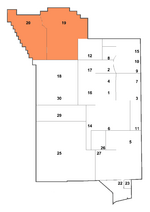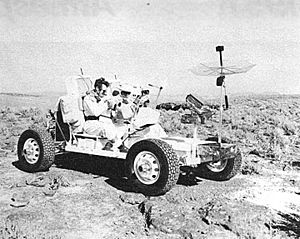Pahute Mesa facts for kids

Pahute Mesa (pronounced "pah-HOOT mee-sah") is a special area in the Nevada National Security Site (NNSS). It's one of four main places where nuclear tests used to happen. This large area covers about 243 square miles in the northwest part of Nevada. It is divided into two sections: Area 19 on the east and Area 20 on the west.
Contents
Why Was Pahute Mesa Chosen?
After 1963, a new rule called the Partial Test Ban Treaty stopped nuclear tests from happening in the air. This meant all future tests had to be done underground. Scientists needed a place that could handle very powerful underground tests, even bigger than those done at Yucca Flat.
Pahute Mesa was perfect because of its geology (the study of rocks and soil) and its distance from cities. It's more than 100 miles (160 km) away from Las Vegas. Engineers could drill holes deeper than 4,500 feet (1,370 meters) into the ground. This allowed very large tests, called "megaton" tests, to be fully contained underground. This meant people in Las Vegas would barely feel any ground shaking.
Because of these reasons, Pahute Mesa became part of the NNSS in late 1963. This happened after an agreement between the United States Atomic Energy Commission and the U.S. Air Force.
What is Pahute Mesa Like?
Pahute Mesa is part of a larger area called the Tonopah Basin. It includes an old volcano area known as the Silent Canyon caldera complex.
The land here is very rugged, with lots of hills and rough ground. Winters can be very harsh, with cold weather and snow. This makes it difficult to work there all year round.
Nuclear Testing History
Between 1965 and 1992, 85 nuclear tests were carried out at Pahute Mesa. Three of these tests were extremely powerful, with a yield of over one megaton. These were named Boxcar, Benham, and Handley. Some tests were also part of special projects like operation Plowshare and Vela Uniform.
In 1988, something special happened. The United States and the Soviet Union worked together on two tests. This was to prepare for new agreements called the Threshold Test Ban Treaty and the Peaceful Nuclear Explosions Treaty. The first joint test was Kearsarge, done in Area 19 of the NNSS. The second was Shagan, which took place in the Soviet Union.
One test, named Greenwater, was planned for 1993. However, nuclear testing stopped in 1992, so this test was never completed. The equipment was left in place in Area 19.
Radioactive Material Release
Some of the tests at Pahute Mesa caused small amounts of radioactive material to be released into the air. This material was detected outside the NNSS. Here are some of those tests:
| Test | Date | Type | Purpose | Location | Amount of iodine-131 released into air |
|---|---|---|---|---|---|
| Palanquin | 1965-04-14 | Crater | Plowshare | Area 20 | 910 kCi |
| Cabriolet | 1968-01-26 | Crater | Plowshare | Area 20 | 6 kCi |
| Schooner | 1968-12-08 | Crater | Plowshare | Area 20 | 15 kCi |
The Schooner test, for example, spread tiny amounts of plutonium and other radioactive materials. This spread across Area 20 and north into the Nellis Air Force Range. Scientists measured the Schooner crater in 2001. They found it had the highest amount of radioactive water (called tritiated water) compared to other areas of the NNSS.
Training for Astronauts

The area around the Schooner crater looks a lot like the surface of the Moon. Because of this, it was used to train astronauts for the Apollo program. Famous astronauts like Neil Armstrong, Dick Gordon, Buzz Aldrin, Dave Scott, and Rusty Schweickart trained here.
In 1970, the Apollo 16 team, including John Young and Charlie Duke, practiced driving the lunar rover at the Schooner site. This helped them prepare for their mission to the Moon.
Support Buildings and Airstrips
The Pahute Control Point is a building located in Area 18, just south of Pahute Mesa. It was used until 1971 to keep an eye on the tests happening in Pahute Mesa.
There is also an airport nearby called the Pahute Mesa Airstrip, also in Area 18. This airstrip was used to bring supplies and equipment to Pahute Mesa.



